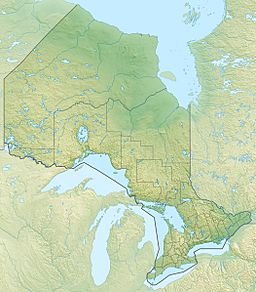Wolverine Lake (Cochrane District) facts for kids
Quick facts for kids Wolverine Lake |
|
|---|---|
| Location | Cochrane District, Ontario |
| Coordinates | 49°49′55″N 83°45′21″W / 49.83194°N 83.75583°W |
| Type | Lake |
| Part of | James Bay drainage basin |
| Primary inflows | Valentine River, Wolverine Creek |
| Primary outflows | Valentine River |
| Basin countries | Canada |
| Max. length | 5.7 kilometres (3.5 mi) |
| Max. width | 1.3 kilometres (0.81 mi) |
| Surface elevation | 235 metres (771 ft) |
| Settlements | Fontaine's Landing |
Wolverine Lake is a lake located in the northern part of Ontario, Canada. It's found in an area called the Cochrane District. This lake is a key part of a large water system that eventually flows into James Bay.
Where is Wolverine Lake?
Wolverine Lake is situated in two geographic areas: Hanlan Township and Bannerman Township. Both of these are within the Cochrane District in Northeastern Ontario. This region is known for its many lakes and rivers.
The lake itself is about 5.7 kilometres (3.5 mi) long and 1.3 kilometres (0.81 mi) wide. It sits at an elevation of 235 metres (771 ft) above sea level.
How Water Flows Through the Lake
Wolverine Lake is an important part of the James Bay drainage basin. This means all the water from the lake eventually makes its way to James Bay. The lake is also part of the Valentine River system.
Water flows into Wolverine Lake from two main sources:
- The Valentine River, which comes from Hanlan Lake to the southwest.
- Wolverine Creek, which flows in from the north.
The water then flows out of Wolverine Lake from its eastern side. This outflow is also the Valentine River.
The Journey to James Bay
After leaving Wolverine Lake, the Valentine River continues its journey. It flows into another lake called Lac Pivabiska. From there, the water travels through the Pivabiska River.
Next, it joins the Missinaibi River, which then flows into the Moose River. Finally, the Moose River empties all this water into James Bay. This shows how Wolverine Lake is connected to a much larger network of rivers and lakes across Canada.


